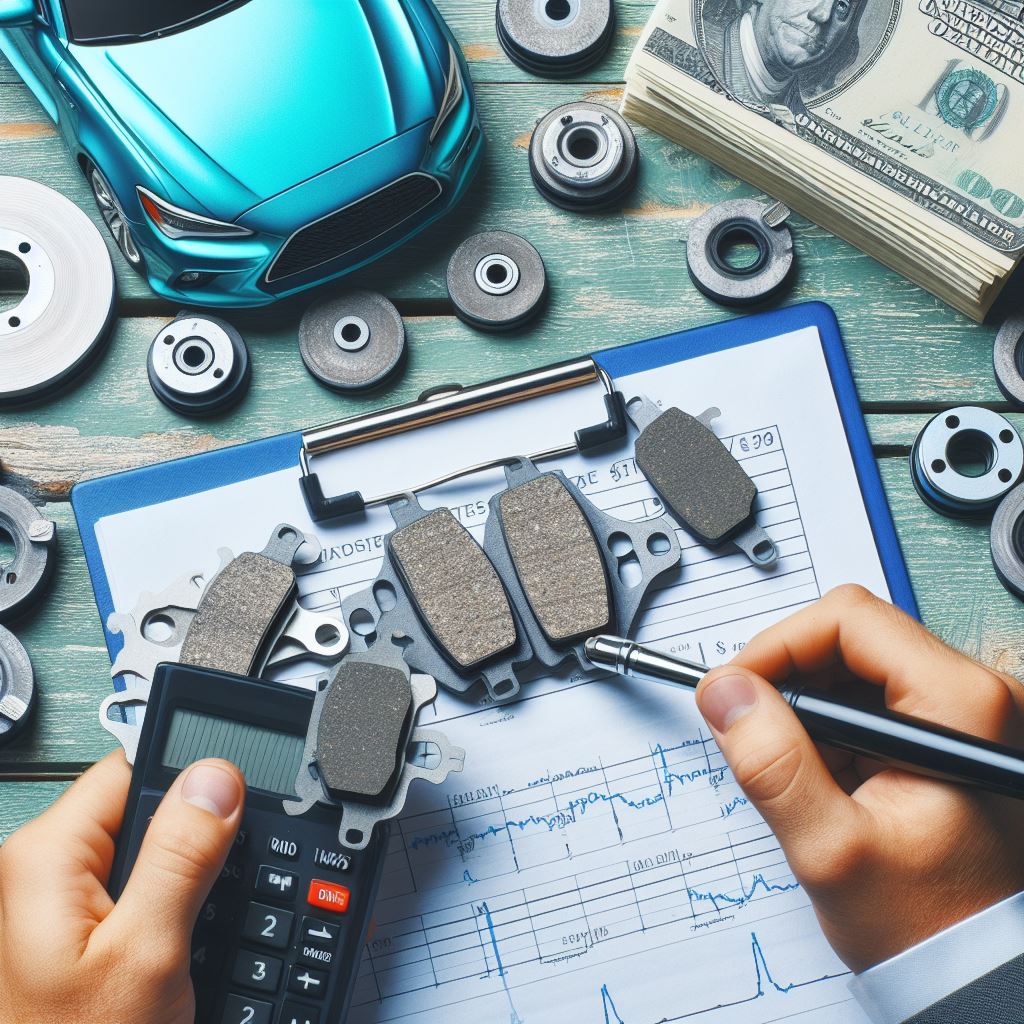How Much Are Brake Pads| Affordable Brakes Pads
Whether cruising down the open road or navigating city streets, your vehicle’s safety depends on reliable brakes. When it’s time to replace your brake pads, you might wonder about the cost. Fear not! We’re here to steer you in the right direction by exploring brake pad prices that won’t leave your wallet spinning.
From budget-friendly options to premium picks, let’s delve into the world of brake pads and find the perfect fit for both your car and your budget. Get ready to stop stress in its tracks and keep your ride safe without breaking the bank!
Table of Contents
- What’s the Average Cost to Replace Brake Pads?
- Factors that Affect Your Brake Pads Cost:
- Can you reduce the brake pads changing cost?
- Some affordable Brake Pads Are Right for You:
- Frequently Asked Questions [FAQs]
- Conclusion
What’s the Average Cost to Replace Brake Pads?
The cost to replace brake pads can vary based on several factors, including the make and model of your vehicle, the type of brake pads you choose, and where you get the work done. On average, the cost for a basic brake pad replacement typically falls within the range of $100 to $300 per axle. This cost includes the price of the brake pads themselves and the labor involved in the installation.
Here are some key factors that can influence the cost:
Type of Brake Pads:
- Standard brake pads are generally more affordable, while high-performance or specialized pads may come at a higher cost.
- Vehicle Make and Model:
- Luxury or high-end vehicles often require specialized brake components, which can increase the overall cost of the replacement.

- Labor Costs:
- Labor costs can vary based on the location and the specific auto repair shop. Dealerships and specialized brake service centers may charge more for their services compared to independent mechanics.
- Additional Components:
- Sometimes, additional components such as rotors or calipers may need replacement or resurfacing, adding to the overall cost.
- DIY vs. Professional Installation:
- If you have the skills and tools to replace brake pads yourself, you can save on labor costs. However, professional installation ensures proper fitting and reduces the risk of errors.
It’s important to note that these are average estimates, and actual costs may vary. It’s advisable to obtain quotes from multiple sources and inquire about any additional fees to get a more accurate understanding of the total cost for replacing brake pads on your specific vehicle. Regular maintenance of your vehicle’s braking system is essential for safety, so it’s crucial to address any issues promptly, even if it involves a certain cost.
Estimated Total Cost for Brake Pad Replacement: $230 – $540 (for all wheels)
Please note that the costs mentioned are approximate ranges and can vary based on factors like the type of vehicle, the quality of brake pads, labor costs, and location-specific pricing. Getting specific quotes from local service providers for accurate pricing is always recommended.
Factors that Affect Your Brake Pads Cost:
Certainly, several factors can influence the cost of brake pad replacement. Here are some of the key factors that can impact the overall price:
- Vehicle Type and Model: Different vehicles have varying brake pad specifications. High-performance vehicles or luxury cars might require specialized brake pads that could be more expensive.
- Brake Pad Material: Brake pads come in various materials, each with its own characteristics in terms of performance, longevity, and cost. Ceramic and semi-metallic pads are often pricier than organic pads due to their superior performance.
- Brake Pad Brand: Numerous brands offer brake pads, ranging from budget-friendly options to premium brands. Premium brands may come with a higher cost but often offer better durability and performance.
- Location and Labor Costs: Labor costs can vary depending on where you have the brake pads replaced. Urban areas or regions with a higher cost of living might have higher labor rates.
- Type of Shop: Dealerships tend to have higher labor rates compared to independent repair shops. Additionally, specialized brake shops might charge differently.
- Additional Services: Sometimes, during brake pad replacement, other components might need attention, such as brake rotors or calipers. Replacing these components will add to the total cost.
- Warranty and Guarantees: Some brake pad manufacturers offer warranties or guarantees, which can affect the price. Higher-quality pads might come with longer warranties.
- DIY vs. Professional Installation: While some people opt for do-it-yourself brake pad replacement to save on labor costs, having the necessary tools and expertise to ensure safety and proper installation is important.

- Location-Specific Pricing: The cost of living and market dynamics in your area can impact the cost of parts and labor.
- Front vs. Rear Wheels: Replacing brake pads on the front wheels is generally more common due to the greater braking force exerted by the front brakes. Replacing pads on all four wheels will naturally be more expensive.
- The urgency of Service: If your brakes need immediate attention due to safety concerns, you might have to pay more for expedited service.
It’s important to consult with reputable mechanics or service centers to get accurate estimates for brake pad replacement based on your specific vehicle and location. This will help you budget effectively and make an informed decision.
Related Post: How To Choose The Best PFC Brakes Pads
Can you reduce the brake pads changing cost?
Yes, you can. Researching the ideal brake pads for your vehicle is essential, as specific types of brake pads are better suited for certain vehicle models. Conduct thorough online research to understand which brake pads align with your requirements.
Obtaining quotes from various mechanics is a prudent step. You can secure the most competitive price for your brake pad replacement by comparing quotes from multiple sources. Familiarize yourself with the optimal time for brake pad replacement.
You can measure the brake pads yourself by following instructional videos on platforms like YouTube. Alternatively, you can request a quick inspection from a mechanic during routine maintenance, such as an oil change. Timely replacement prevents rotor damage, which can result from delaying the replacement process.
Incorporate brake pad replacement into your maintenance plan. If you plan on using your vehicle for an extended period, anticipate needing brake pad replacements at least once. It’s a crucial aspect of vehicle maintenance that should not be overlooked. By proactively planning for this maintenance, you can avoid unexpected financial surprises when the time comes.
Some affordable Brake Pads Are Right for You:
- Bosch QuietCast Premium Ceramic Brake Pads:
- Material: Ceramic
- Features: Low dust, quiet operation, consistent braking performance, hardware included
- Benefits: Ceramic pads provide good stopping power, reduced noise, and less dust than traditional semi-metallic pads.
- Compatibility: Suitable for many vehicles, including sedans and compact cars.
- Akebono ACT787 ProACT Ultra-Premium Ceramic Brake Pads:
- Material: Ceramic
- Features: Low dust, minimal noise, high-quality friction material, excellent stopping power
- Benefits: Akebono is known for producing high-quality ceramic brake pads with consistent performance and durability.
- Compatibility: Fits various car models, including SUVs and trucks.
- Wagner QuickStop Ceramic Disc Brake Pads:
- Material: Ceramic
- Features: Quiet operation, reduced vibration, good braking performance, low dust
- Benefits: Wagner is a trusted brand in the automotive industry, offering ceramic pads that provide reliable stopping power with minimal noise and dust.
- Compatibility: Suitable for passenger cars and light trucks.
- Power Stop Z23 Evolution Sport Brake Pads:
- Material: Carbon-fiber ceramic hybrid
- Features: Enhanced heat dissipation, strong initial bite, low dust, upgraded performance
- Benefits: These performance-oriented pads are designed for drivers seeking improved braking response and fade resistance.
- Compatibility: Suitable for sportier vehicles and enthusiasts.
- ACDelco Advantage Ceramic Front Disc Brake Pad Set:
- Material: Ceramic
- Features: Dependable braking performance, quiet operation, reduced dust
- Benefits: ACDelco is a reputable brand, and its Advantage line offers affordable yet reliable brake pads for everyday driving.
- Compatibility: Designed for various vehicles, including midsize and compact cars.
Remember that while affordability is important, safety is paramount. Always ensure that any brake pads you choose are compatible with your vehicle’s specifications and are manufactured by reputable brands. Additionally, if you’re not comfortable with DIY installation, it’s advisable to have a qualified mechanic install the brake pads to ensure proper function and safety.
Also, Learn How To Replace The Pads On Your SRAM Code R Brakes
Frequently Asked Questions
1. How long does a brake job take?
A brake job takes about 30 minutes to an hour. In some cases, it can be more depending on the vehicle. But for someone with no experience, it can take several hours.
2. How much does it cost for four brake pads?
All four brake pads cost about 35 to 150 dollars. Labour cost between $80 and $120 per axle.
3. How often do brake pads need replacement?
Experts advise getting your brake pad replaced after every 10,000 to 20,000 miles. This is the minimum mile to keep wear to the minimum. As for your rotor, it should be replaced between 50,000 to 70,000 miles. Anything higher will be unsafe.
4. What happens if you don’t replace the brake pads?
If you don’t replace brake pads before when damaged, it can affect other components of the braking system. It will mostly affect the brake disc or drums. It also results in unsafe driving for you and other road users.
Conclusion
The prices of a brake pad varies with the manufacturer and vendor. However, when getting a brake pad, you must consider the quality, driving pattern, and environment. Cost should be the least consideration because going for low-quality brake pads will only require frequent change. That’s because they get worn out on time. Most modern braking systems are self-adjusting. So, they self-adjust to ensure the brake pad maintains constant contact with the rotor when the brake is applied.
